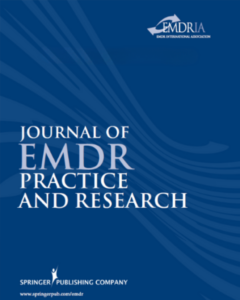How does EMDR work? (Journal of Experimental Psychopathology)
Paper on the findings of a long series of experiments that disproved the hypothesis that eye movements or other ‘dual tasks’ are unnecessary.
Read MoreSuggestions pour l’enseignement de l’application des mouvements oculaires en EMDR (Journal of EMDR Practice and Research)
Les Questions & réponses cliniques. Question : « En tant que superviseur et animateur EMDR, j’observe souvent que les supervisés et les…
Read MoreTones inferior to eye movements in the EMDR treatment of PTSD (Behaviour Research and Therapy)
Study suggests that eye movements outperformed tones while it remained unclear if tones add to recall only.
Read MorePretreatment, Intratreatment, and Posttreatment EEG Imaging of EMDR: Methodology and Preliminary Results From a Single Case (Journal of EMDR Practice and Research)
Electroencephalography (EEG) was used to monitor neuronal activation during the whole EMDR session, including the autobiographical script.
Read MoreClinical Q&A: Suggestions for Teaching the Application of Eye Movements in EMDR (Journal of EMDR Practice and Research)
Question: “[Are] eye movements are considered superior, and if so, how I can encourage my consultees/trainees to use them.”
Read MoreDo horizontal saccadic eye movements increase interhemishpheric coherence? Investigation of a hypothesized neural mechanism underlying EMDR (Frontiers in Psychiatry)
This study aimed to investigate whether memory enhancement following bilateral eye movements is associated with increased interhemispheric coherence in the electroencephalogram (EEG).
Read MoreEMDR: Eye movements superior to beeps in taxing working memory and reducing vividness of recollections (Behaviour Research and Therapy)
Study compares auditory and eye movement BLS, supports a working memory account of EMDR, and suggests that the effects of beeps on negative memories are inferior to those of eye movements.
Read MoreEMDR effects on pursuit eye movements (PLoS ONE)
This study aimed to objectivize the quality of smooth pursuit eye movements in a standard laboratory task before and after EMDR.
Read MoreA Single-Case fMRI Study EMDR Treatment of a Patient With Posttraumatic Stress Disorder (Journal of EMDR Practice and Research)
Study of EMDR with auditory alternating bilateral stimulation (ABS) using functional magnetic resonance imaging (fMRI) of brain activations.
Read MorePresent and Accounted For: Sensory Stimulation and Parietal Neuroplasticity (Journal of EMDR Practice and Research)
Directional/bilateral alternating peripheral sensory stimulation appear to assist in the amelioration of a wide range of clinical conditions.
Read MoreA Working Memory Explanation for the Effects of Eye Movements in EMDR (Journal of EMDR Practice and Research)
Study tested working memory theory to investigate the effects of eye movement (EM) on the components of autobiographical memory.
Read MoreInterhemispheric Interaction and Saccadic Horizontal Eye Movements: Implications for Episodic Memory, EMDR, and PTSD (Journal of EMDR Practice and Research)
The body of literature on the effects of bilateral saccadic eye movements, patterned after those employed in EMDR, on memory is reviewed.
Read More


